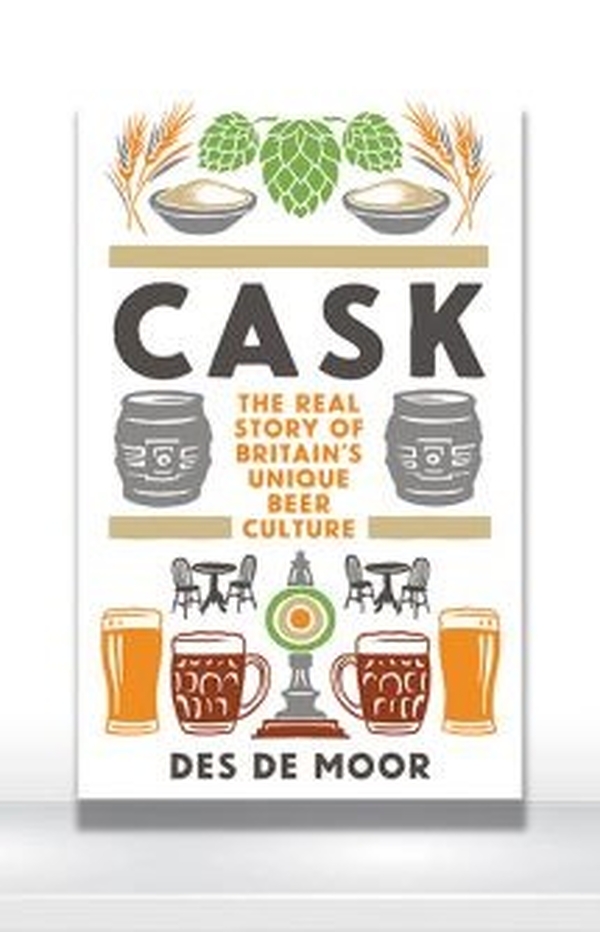In depth history of Britain's beer culture
Added: Monday, October 30th 2023

Cask, Des de Moor (CAMRA Books, £17.99)
The sub-title of the book is The Real Story of Britain’s Unique Beer Culture but this promise is not met until page 167. The first 166 pages are devoted to a detailed explanation of the brewing processes for both ale and lager followed by descriptions of the various containers used to store beer – casks, kegs, bottles, growlers and cans – the range of beer styles available and paring them with food.
Finally, we get to the pledge of the title, a fascinating history of Britain’s singular contribution to world beer – ale that matures and conditions not in the brewery but the pub cellar. Both Des and the publisher would no doubt argue that the first sections are aimed at readers new to beer, not old crusties such as me. Younger drinkers should indeed to be told about brewing processes and the differences between ale and lager but surely this could have been the latter half of the book.
Once the history of British beer is underway, it’s a gripping read. Des takes us through the origins of brewing in this country, the influence of monastic beer-making, the late arrival of hops from Europe and the rise of commercial production in the 18th and 19th centuries.
Des rightly says that those two centuries turned brewing “from what was effectively a cottage craft into one of the first major large-scale industries, the vanguard of the industrial revolution”. The transformation was led by porter brewing in London in the 18th century: Des bravely offers his interpretation of the origins of the style – brave, as there is no shortage of “experts” who, even without the aid of a time machine, threaten to eviscerate anyone who departs from their version of the truth. Des puts forward what is now widely accepted as the most likely explanation for how the first porters were brewed: beers made with cheap brown malts and aged in oak for several months in order to become drinkable.
The 19th century and the development of pale ale and bitter are of profound importance. It saw the gradual decline and disappearance of beers aged for months and years in wooden vats and the widespread introduction of “running beers” in casks that could be served within a few days of reaching pub cellars.
The first pale ales, however, were aged. They were called October Beers, brewed with the first malts and hops of the harvest and matured for as long as a year before they were considered fit for drinking. These were the beers that were sent to the British in India and became known as India Pale Ale.
It’s disappointing to find that Des de Moor repeats the urban myth that IPA “was not technically real ale”. Paul Bayley, the now retired head brewer at Marston’s in Burton-on-Trent who made a close study of the subject, says “yeast as much as alcohol and hops kept beer destined for India in good condition”. The British stationed in the sub-continent, desperate for refreshing beer, complained that the beers sent to them had too much sediment and took too long to “ripen”, to use a Victorian term. It’s true that, before casks destined for India were loaded into ships’ holds, the bungs were loosened to vent off excess carbon dioxide to prevent explosions en route. But in order to allow further gas to vent during voyages, the casks had special porous venting plugs made of red oak placed in the bungs. Staves of oak were twice as thick as those used for domestic casks and they were criss-crossed with hoops at each end to prevent explosions: see photo of casks in the National Brewery Centre in my book The Story of Brewing in Burton-on-Trent.
We’re on safer ground in the 20th century. Des guides the reader through the attack on beer during World War One with astonishing increases in excise duty to oil the wheels of war. As a result, strong beers such as IPA and stout all but disappeared.
A different threat emerged following World War Two: the boom in bottled beer that led to filtered and pasteurised keg beer that sent cask beer into a tail spin. The problem was exacerbated in the 1960s and 70s as a result of “merger mania” that saw the arrival of giant national brewing group hell-bent on promoting keg and so-called lager that further dented sales of cask.
The decline was halted by the arrival of CAMRA in the early 1970s. Its beer festivals, publications, marches and protests, brought real ale to the attention of a new audience of beer drinkers. Independent breweries were saved and the new century has seen scores of new small breweries adding to choice and diversity.
Now there’s the new challenge of craft keg beers and the dramatic loss of sales of cask as a result of Covid and pub lockdowns. Des has spoken to brewers large and small about the future of cask and shows that while some argue for it to be treated as a premium product with a higher price, others are concerned about it losing its appeal as a beer for the common people.
It’s an important debate but most brewers are convinced, given a fair crack of the whip by government where taxes are concerned, cask beer can grow again: Rupert Thompson, owner of Hogs Back Brewery in Surrey, believes it may be “discovered by a new generation”.
Let’s hope so. Des de Moor should be congratulated on producing a superbly written and deeply researched book. My disagreement on a few points should be taken as a contribution to a convivial debate. Des may take these points on board for any reprints of this worthy book while the publisher might give thought to its planning and presentation.




